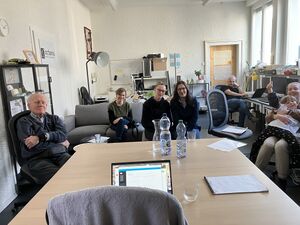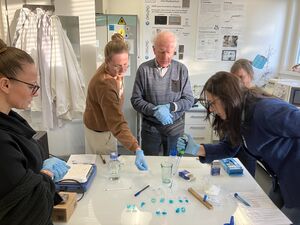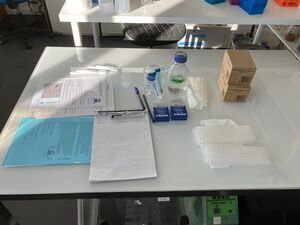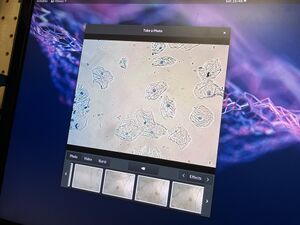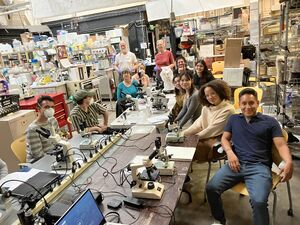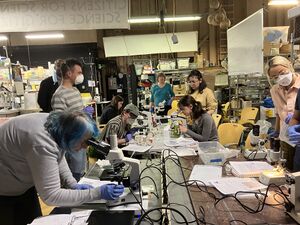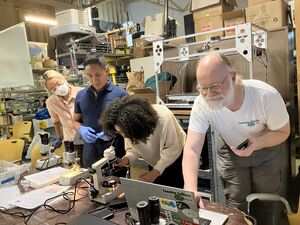Difference between revisions of "Micronucl"
| (9 intermediate revisions by the same user not shown) | |||
| Line 42: | Line 42: | ||
| − | Have a look at the [https://prezi.com/ | + | Have a look at the [https://prezi.com/view/hLS7gsFv0p5n8YpOGVd5/ Prezi for the workshop done 18may19)]! |
Here is the 'timelapse' made during the workshop [https://vimeo.com/337737746 two hours in 30s]??<br> | Here is the 'timelapse' made during the workshop [https://vimeo.com/337737746 two hours in 30s]??<br> | ||
| Line 55: | Line 55: | ||
After an initial visit to Colombia, where there are problems of mercury contamination due to mining, and one river, the Atrato, has actually been given 'human rights' through legal actions to help protect it, the idea is to do micronuclei workshops for a project co-sponsored by ProHelvetia and the Colombian Association, Màs Arte, Màs Acción. | After an initial visit to Colombia, where there are problems of mercury contamination due to mining, and one river, the Atrato, has actually been given 'human rights' through legal actions to help protect it, the idea is to do micronuclei workshops for a project co-sponsored by ProHelvetia and the Colombian Association, Màs Arte, Màs Acción. | ||
More information will soon be available on a new wiki page, [[Micronuclei and Mercury]]. | More information will soon be available on a new wiki page, [[Micronuclei and Mercury]]. | ||
| + | |||
| + | |||
| + | '''A special workshop sponsored by JOGL/SOPBio''' | ||
| + | |||
| + | for our first in person micronucleus workshop since the pandemic began! | ||
| + | |||
| + | It was the 21st of January and very nice... | ||
| + | |||
| + | We got special JOGL/SOPBio support for [https://app.jogl.io/project/1420 the proposal], | ||
| + | |||
| + | Here was [https://prezi.com/view/PSZHlClFA1qYAOtwAxR4/ RA's Prezi for the day], bilingual (FR/EN) | ||
| + | [[File:After prezi.jpg|center|thumb|just 7 participants, counting Dujana - but 2 were entirely new to the lab...]] | ||
| + | [[File:Making slides.jpg|thumb|methylene blue stains nuclei]] | ||
| + | and here are some pictures! One of the participants provided cells for a workshop long ago, and looks forward to comparing her micronuclei counts... (No one got to 1000 cells with good nuclei, yet, but a few promised to come back!) | ||
| + | [[File:Labbench.jpg|left|thumb|Ready for the participants!]] | ||
| + | [[File:Stained cells.jpg|center|thumb|stained inner cheek cells]] | ||
| + | |||
| + | |||
| + | '''A special workshop in California at another community lab: CounterCulture Labs''' | ||
| + | |||
| + | Hosted by Patrik d'Haeseleer, who Rachel met during the pandemic time and around biosafety issues and Biosummit open publication planning, this [https://www.meetup.com/counter-culture-labs/events/294058046/ will be held on 13October]2023, on a Tuesday when the group ordinarily has their environmental justice discussions! | ||
| + | |||
| + | Here is [https://doi.org/10.1093/mutage/gem004 an article] that helps explain why Patrik is so interested in this method. | ||
| + | [[File:Counterculture3.jpg|thumb|after the presentation, at Counter Culture labs]] | ||
| + | |||
| + | [[File:CounterCulture2.jpg|thumb|a diverse group came out for the workshop!]] | ||
| + | |||
| + | This is [https://prezi.com/view/NPERdAltQMyqD5ue05rI/ the prezi planned] for the introductory presentation. | ||
| + | [[File:CounterCulture1.jpg|thumb|checking out the slides]] | ||
| + | |||
| + | === Another West Coast workshop: SoundBio Lab === | ||
| + | Of course, more micronuclei were seen in Switzerland, for instance during a workshop 18feb2024, but while in Seattle, [https://www.sound.bio/workshops-events/dna-damage-hrgn8-l86ex-e5mz9 another workshop was run on Sept 18, 2024 at the SoundBio community lab] in Seattle. Here are [https://drive.google.com/drive/folders/1B1-lKYRfyxLYycJ50S32Dj_mZn7wJJk8 some images] from the evening, for a great group which included two teen participants. | ||
Latest revision as of 15:24, 17 February 2025
French version beta version!
A protocol for the cheek cell micronuclei tests follows:
(as all molecular microbiologists are aware, each researcher will have their particular ways to do the same things... our take on it all is that many methods may work well indeed and should be shared more!)
A basic DIT-research protocol to look for micronuclei in your own cheek cells
Note: To ideally work in pairs, at least, and score one another's cells after preparation.
This helps avoid problems of human reporting bias, it is believed.
Protocol:
- rinse mouth well with water
- use toothbrush to gently collect cells from inner cheek surface
- wash off toothbrush into little beaker with about 10ml of saline solution
- pour into 15ml conical to allow largest clumps to settle away and
- pellet cells from best part of liquid into two microcentrifuge tubes
- spin gently (no more than 5k rpm ) for 3min
- pour off supernatants, and repeat until all cells are collected
- pool pellets from the two tubes into one tube, in about 200ul saline solution
- get cell concentration of this solution (want to aim for 2000-5000 cells per slide)
- use 10ul to count on hemocytometer (the calculation if you count several cells (X) of the size of the main square = (X*#cells/X) per main square x10^4/ml)
- If necessary spin again to concentrate cells again in a small volume, as, ideally, for 'smears' will put drops of less than 50-100ul, containing about 2000 cells, onto each slide.
- Make sure slides are clean and labelled before proceeding to smears.
- (To demonstrate during workshops)
- place drop about 3/4 to end of slide, then with the edge of a second clean slide move the drop back, then smear it all forward (need pics too...)
- Let each slide air dry, can place on a hot plate.
- Fix cells to slide by briefly passing over a flame (remove soot from bottom before going onto staining).
(optional fix with methanol:acetic acid 3:1)
Stain cells with Methylene Blue (0.5% aqueous, unless optional fix – then can be made up in ethanol...)
If have slide dipping containers, coplin jars, so much the better, but can also just put a drop on the slide.
Leave stain on at least 1min then rinse with drops of water, collecting blue waste liquid* in a beaker. Let sample dry and examine under a microscope at about a 200x magnification.
Quantitation is crucial – micronuclei can arise from normal processes, but an increase of 2-4/1000 to 20 or more per 1000 cheek cells could mean one should consider deleterious environmental exposures ...
Figure 1 shows one example cheek cell containing a micronucleus, smeared, fixed and stained simply with methylene blue.
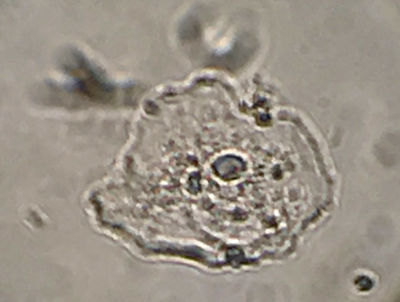
Have a look at the Prezi for the workshop done 18may19)!
Here is the 'timelapse' made during the workshop two hours in 30s??
A First Real Experiment!?
For a recent micronucleus workshop (18may19), two sisters gave their cells to us to test blind (just had samples A and B).
After counting 2 slides for each (>2000 cells), one had about 3 micronoyaux per 1000 cells and the other about 11, but it was in the opposite sense than what I predicted! (the more sporty sister actually had more…).
Anyway, both are in the ‘normal / low’ range! (basically the same given variance), but we suspect the older sister has less stress in her life, or deals with it better...)
It is with more than 20 or 50 per 1000 cells that we say one should reconsider lifestyle choices (and maybe see a doctor!)!!
More Experiments Ahead in the context of Mercury Exposure!? After an initial visit to Colombia, where there are problems of mercury contamination due to mining, and one river, the Atrato, has actually been given 'human rights' through legal actions to help protect it, the idea is to do micronuclei workshops for a project co-sponsored by ProHelvetia and the Colombian Association, Màs Arte, Màs Acción. More information will soon be available on a new wiki page, Micronuclei and Mercury.
A special workshop sponsored by JOGL/SOPBio
for our first in person micronucleus workshop since the pandemic began!
It was the 21st of January and very nice...
We got special JOGL/SOPBio support for the proposal,
Here was RA's Prezi for the day, bilingual (FR/EN)
and here are some pictures! One of the participants provided cells for a workshop long ago, and looks forward to comparing her micronuclei counts... (No one got to 1000 cells with good nuclei, yet, but a few promised to come back!)
A special workshop in California at another community lab: CounterCulture Labs
Hosted by Patrik d'Haeseleer, who Rachel met during the pandemic time and around biosafety issues and Biosummit open publication planning, this will be held on 13October2023, on a Tuesday when the group ordinarily has their environmental justice discussions!
Here is an article that helps explain why Patrik is so interested in this method.
This is the prezi planned for the introductory presentation.
Another West Coast workshop: SoundBio Lab
Of course, more micronuclei were seen in Switzerland, for instance during a workshop 18feb2024, but while in Seattle, another workshop was run on Sept 18, 2024 at the SoundBio community lab in Seattle. Here are some images from the evening, for a great group which included two teen participants.
